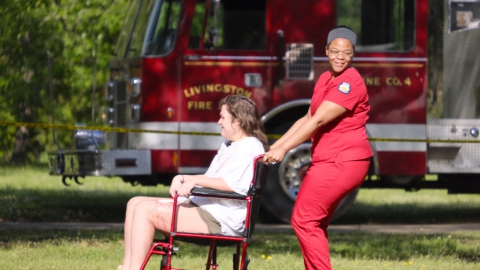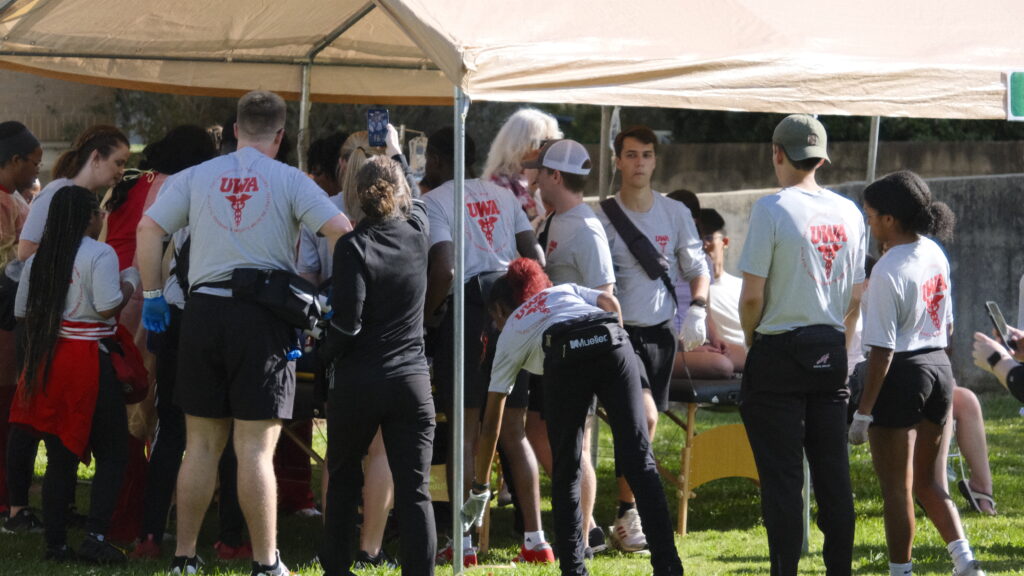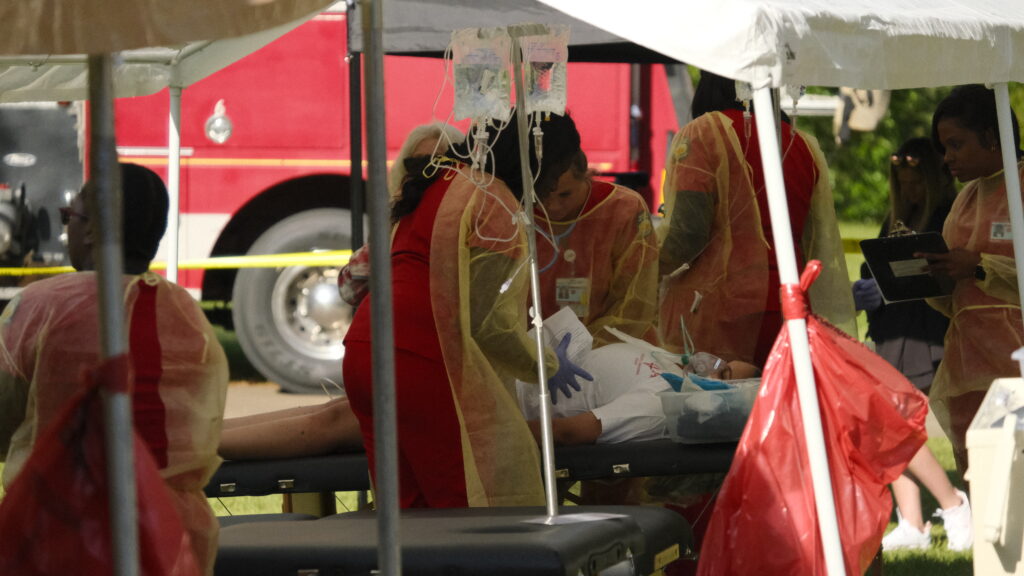
Story: Phillip Tutor | Photos: Brandon Miller
Students gained experience in triaging and treatment during emergency situations
Dalton Meador, a sophomore at the University of West Alabama, is unabashedly proud of his academic major. He fancies a career in health care, and he enjoys sports. Athletic training fulfills both desires.
“I feel like it’s my calling,” he said.
At UWA, the Tuscaloosa native didn’t expect to learn how to treat gunshot wounds or respond to large-scale medical emergencies. But more than a week after participating in a mass casualty simulation exercise, Meador still can’t temper his reaction.
“It was very much an adrenaline rush, a very chaotic — organized chaos,” he said.
Translation: He loved it.
In April, students from several disciplines at UWA took part in an announced simulation that served to give students an important learning opportunity.
“I completely understand why we did it, and I’m thankful for the exposure,” Meador said, “because being in the position that you can be put in as an athletic trainer, you could be the only medical professional available on site, even if it is just providing basic first aid. What we say in our program is, ‘Some is better than none.’”
The exercise was the brainchild of UWA athletic trainer/instructor Taylor Ramsey, who had participated in a similar event as an undergraduate at Heidelberg University in Tiffin, Ohio. Ramsey, the athletic trainer for UWA’s women’s basketball team, developed a character list for more than 20 actors who portrayed a variety of roles: victims with fatal and non-fatal gunshot wounds, open fibula fractures, sprained ankles and other injuries; bystanders suffering from heart ailments and anxiety attacks; and what she calls “distractors” — uninjured people who for myriad reasons were stressing first-responders.

“Maybe they just had a graze wound or had tripped over something in the classroom,” Ramsey said. “But they were like, ‘Why are you not paying attention to me? I’m hurt.’ They were trying to pull our students away from those people who actually needed their medical attention.”
Twenty-one students from the athletic training program participated alongside 16 from UWA’s Division of Nursing and a handful from the university’s theater classes. The nursing students were spread across the simulation: some performed triage duties on patients in a hospital setting, with others transported the wounded or portrayed victims.
Unlike the athletic training students, the nursing majors did not have prior experience in mass casualty simulations, though the division’s curriculum includes “snippets” dedicated to mass casualties and triage techniques, said Dr. Jennifer Harwell, associate professor of nursing. Before the simulation, nursing faculty gave students a broad array of medical conditions they should expect to see, including hemorrhages and patients suffering from shock, gunshot wounds and shrapnel injuries. The faculty, Harwell said, did not specifically tell students how they should treat patients and instead required them to rely on previous training.
“It’s very easy for us to teach them how to triage in the classroom and give them case studies and examples, but until you’re put into a simulation situation, it helps them put theory into practice,” Harwell said. “They were excited, but I think also a little nervous. They didn’t really know what to expect. We got some really good feedback and positive comments.”
Harwell admitted that she was unsure how the students would react during the simulation, given the intensity of the event and presence of law-enforcement officers. “They stepped up to the plate, and within the limitations of a mock hospital setting without a doctor, we thought they performed well,” she said.
To help with the student actors, Ramsey tapped into the expertise of Rhonda Wooley, an assistant professor of theater at UWA. Ramsey sent Wooley a character analysis from a previous simulation at UWA, which allowed Wooley to guide rehearsals and coach actors on what the nursing and athletic training students needed to experience.
“The idea was that some of these students in theater might not be as reticent to take risks and scream and holler and carry on when nothing was actually wrong,” Wooley said. “I was picky about who got those particular assignments. I knew which students would go for it and which ones would just be too shy. (Ramsey) knew theater students might be a little bit more willing to go nuts and do exactly what they needed to do, whereas maybe some other students would be like, ‘There’s no way. Yeah, I’ll play dead, but that’s about all you’re going to get.’”
Athletic training major Laraleigh Roberts, a junior from Lauderdale, Mississippi, expected the simulation would include a crush of actors and potential scenarios. But Ramsey and the event’s other organizers hadn’t told them if they’d be responding to a simulation of an active shooter or some other emergency.
But the realness of the simulation was evident as soon as it began.

“When we first got on the scene, we didn’t have a lot of time to do a thorough triage,” Roberts said, explaining that the first dramatized victim appeared to have a gunshot wound to the head, complete with stage-quality special effects makeup to resemble wounds.
That planned uncertainty created stress, just as Ramsey had planned. Students responding to the fictitious wounded “were having all these different situations or scenarios going through our heads,” Roberts said. “A few others were thinking about if there was a bullet wound to the femoral artery, how would we stop that bleeding? We were constantly trying to mentally prepare ourselves.”
A few days after the simulation, Ramsey looked back with a sense of pride over how the students performed. Faculty know that UWA’s curriculum had developed students’ skills, she said, and that one of the simulation’s biggest values was boosting their confidence in high-stress situations.
For her, it also scratched an itch.
“I have always had that love for the emergency care side of athletic training,” she said. “You get the adrenaline rush. You’re helping people. You have to do what you have to do.”